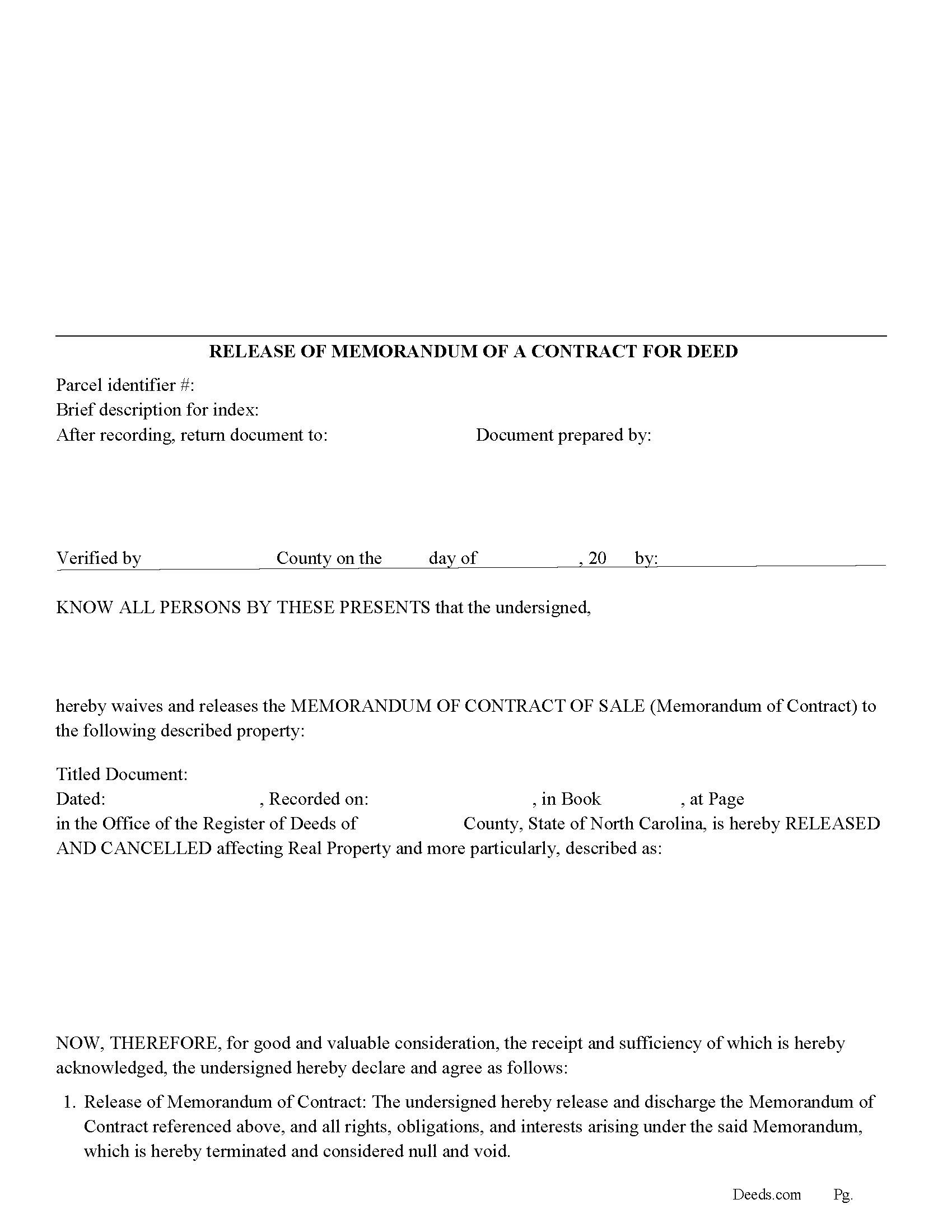North Carolina Release of a Memorandum of a Contract for Deed Forms
Choose Your County
North Carolina Release of a Memorandum of a Contract for Deed Overview

About North Carolina Release of a Memorandum of a Contract for Deed Forms
Our release of a memorandum of a contract for deed forms are specifically formatted for each county in North Carolina. This ensures your documents meet all local requirements and will be accepted for recording without delays or rejection fees.
In North Carolina, a release of a Memorandum of a Contract for Deed is a legal document used to formally terminate or cancel a previously recorded Memorandum of a Contract for Deed, indicating that the underlying contract for deed (also known as a land contract) is no longer in effect. Below, I’ll explain its purpose and who should sign it, based on North Carolina law and general real estate practices, while incorporating relevant details from the provided web results.
Purpose of a Release of a Memorandum of a Contract for Deed: A Memorandum of a Contract for Deed is recorded in the county register of deeds to publicly notify that a property is under a contract for deed, protecting the buyer’s equitable interest and preventing the seller from encumbering or selling the property to another party without notice. A release of this memorandum serves the following purposes:
• Termination of the Contract: It signals that the contract for deed has been terminated, either because:
• The buyer has fulfilled all payment obligations, and the seller has conveyed the deed, completing the transaction.
• The parties mutually agreed to cancel the contract.
• The buyer defaulted, and the seller exercised forfeiture rights after proper notice and failure to cure, extinguishing the buyer’s equitable interest.
• Clearing the Property Title: The release removes the memorandum from the public record, clearing any cloud on the property’s title. This ensures the seller can freely convey the property to another party or refinance without encumbrances tied to the prior contract.
• Legal Protection: It provides clarity to third parties (e.g., future buyers, lenders) that the contract for deed is no longer active, preventing disputes or claims on the property.
For example, if the buyer paid off the contract, the release confirms the transaction’s completion. If the contract was canceled (e.g., within the three-day cancellation period allowed under N.C. Statute 47H-2 or due to default), the release documents the termination.
Who Should Sign the Release? The signatories depend on the circumstances of the termination, but typically include:
• Seller (Vendor): The seller, who holds legal title to the property under the contract for deed, must sign the release to confirm the contract’s termination and release the memorandum from the public record.
• Buyer (Purchaser): In cases of mutual termination, the buyer should also sign to acknowledge the cancellation of the contract and their equitable interest in the property. This is explicitly required for a mutual termination under N.C. Statute 47H-2(e), which states that a mutual termination must be executed by both parties and recorded in the county register of deeds.
• Notary Public: The signatures of the seller (and buyer, if applicable) must be acknowledged by a notary public to meet North Carolina’s acknowledgment requirements for recording. This ensures the document complies with N.C. Statute 47-38 and is valid for registration.
Additional Notes:
• If the termination results from a forfeiture due to the buyer’s default, the seller may sign unilaterally after providing proper notice of default and intent to forfeit (per N.C. Statute 47H-4) and the buyer’s failure to cure within the specified period (at least 30 days).
• The release must be recorded in the office of the register of deeds in the county where the property is located, typically by the seller, unless the parties agree otherwise.
Practical Details
• Content: The release should reference the original Memorandum of a Contract for Deed, including the names of the parties, property description, and date of the original contract. It may also note the reason for termination (e.g., fulfillment, mutual cancellation, or forfeiture).
• Recording: Like the original memorandum, the release must be filed with the county register of deeds to update the public record.
• Format: The document must comply with North Carolina’s recording requirements, such as those outlined in N.C. Statutes and local county rules.
Example Scenario
• Completion of Contract: An Individual buys a property under a contract for deed, pays all installments, and the seller conveys the deed. The seller signs a release of the memorandum, notarized, and records it to clear the title.
• Mutual Cancellation: If buyer and the seller agree to cancel the contract within the three-day cancellation period or later, both sign a mutual termination and release, which is notarized and recorded.
• Default: If the buyer defaults and fails to cure after notice, the seller signs the release alone after forfeiture procedures, documenting the termination.
Our forms are specifically formatted for each county to ensure acceptance.